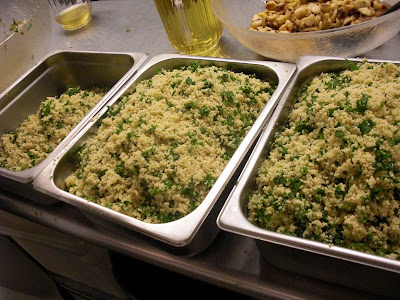The first commercial kitchen I ever cooked in was at a hippie alternative community dance camp called Dance New England (DNE), starting when I was 6 years old. Everyone in the community was required to help out with cooking, cleaning and making the 10 day summer gathering happen. The food I remember from the early days was what I now think of as Moosewood cuisine (as in the cookbook and restaurant). I remember blackstrap molasses, steamed vegetables, buckets of tahini, brown rice, peanut butter, and lots of bodies cooking, dancing, swinging, and kids running in the woods dressed in costumes and covered in face paint. Over the next 30 years, the camp grew a lot and moved into the post hippy era. I cooked in the camp kitchen almost every summer till I was about 26 years old. Many great cooks passed through that kitchen. People from Omega and Kripalu Institute's kitchens, cooks schooled in macrobiotics, delicious vegetarian cooking, organic, inspired, reinvented, fresh cooked healthy, tasty food. I remember there being about 6 cooks in the kitchen each summer with dozens of volunteers cycling through in 3 hour shifts for their kitchen chores. Feeding 300-500 people with a staff of volunteers is an incredible feat!
Over the past 10 years, I have only been to dance camp twice, and this year was the first time with both my children. It was great to be back. My time in the kitchen this year was limited to a few short stints, not the exhausting long days cooking for 500 people that the head cooks were pulling. The DNE kitchen was and is a special place. I certainly owe much of my comfort in the kitchen to the years I spent helping out in there as a kid, teen and young adult. Cooking from scratch without recipes, following directions, giving directions and learning how to cook good food in large quantities to feed a whole community. Meals were cooked with attention and respect to allergies and various diets long before the terms gluten free and vegan were as mainstream as they are now. The lessons I learned in this kitchen about cooking, and in this community about life and cooperation have served me very well, and I am grateful.
The first Charlie, now "Chaz" making bread for 500 people daily. Some wheat, some spelt.
The fabulous lunch salad bar. Who would have a hard time eating well
with these wonderful options waiting for them?!
The Kitchen in action
The large immersion blender, once you use one, you'll never go back!
Did you know that you can "cook" kale by massaging it with a little salt and oil? Simple, fresh and delicious. Here we mixed it with some leftover cous cous, lemon juice, roasted garlic and herbs. I remember first learning this technique many years ago, and thinking the cook who
told me to do it was a little wacky, but no, it works and is great!
told me to do it was a little wacky, but no, it works and is great!
Thank you to all the 2010 cooks and community members from Dance New England who fed us for the last 10 days, we miss all that great food already!






















